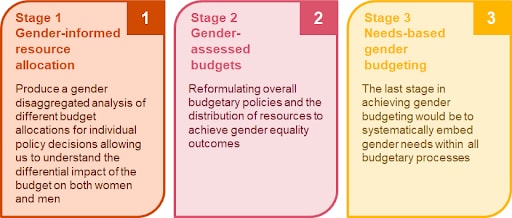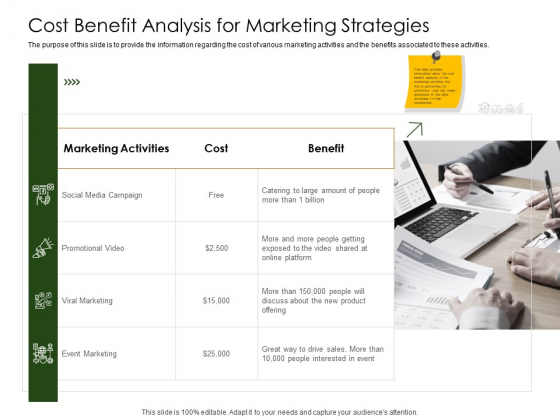Table of Contents
In the fast-paced world of marketing, where budgets are scrutinized, and every dollar spent must yield tangible results, the importance of cost-benefit analysis cannot be overstated. This analytical approach empowers businesses to make informed decisions, maximize return on investment (ROI), and allocate resources efficiently in marketing campaigns. In this article, we delve into the role of cost-benefit analysis in marketing and how it enables companies to evaluate ROI with economic precision.
In the fast-paced world of marketing, where budgets are scrutinized, and every dollar spent must yield tangible results, the importance of cost-benefit analysis cannot be overstated. This analytical approach empowers businesses to make informed decisions, maximize return on investment (ROI), and allocate resources efficiently in marketing campaigns. In this article, we delve into the role of cost-benefit analysis in marketing and how it enables companies to evaluate ROI with economic precision. Here are some key facets to consider:
Strategic Resource Allocation: Cost-benefit analysis is like a compass guiding marketing professionals in allocating resources strategically. By assessing the potential returns of various marketing initiatives, businesses can channel their budgets toward the most promising avenues, optimizing their marketing mix for maximum impact.
Risk Mitigation: Marketing endeavors often carry inherent risks, from uncertain consumer responses to changing market dynamics. Cost-benefit analysis helps in risk assessment by quantifying potential gains and losses, allowing businesses to make calculated decisions that mitigate risks and enhance ROI stability.
Objective Decision-Making: In the face of numerous marketing opportunities and tactics, it’s easy to succumb to subjective preferences or industry trends. Cost-benefit analysis imposes objectivity by providing quantifiable metrics for evaluating marketing options. It replaces guesswork with data-driven decision-making.
Resource Efficiency: Wasteful spending can erode marketing budgets and hamper overall profitability. Cost-benefit analysis identifies underperforming campaigns or channels, allowing businesses to reallocate resources to strategies that deliver a higher return, resulting in cost savings and increased ROI.
Continuous Improvement: Marketing doesn’t operate in a vacuum; it evolves with market trends and consumer behavior. Cost-benefit analysis promotes a culture of continuous improvement. Marketers can analyze campaign performance, identify bottlenecks or inefficiencies, and make adjustments to refine their strategies over time.
Customer-Centricity: By assessing the costs and benefits of marketing initiatives, businesses can better understand their customers’ preferences and behaviors. This insight allows for the development of more customer-centric campaigns that resonate with target audiences, further boosting ROI.
Competitive Advantage: Companies that embrace cost-benefit analysis are often better positioned to gain a competitive edge. They can optimize their marketing efforts, respond more effectively to changing market conditions, and outperform competitors who rely solely on intuition or tradition.
Measuring Long-Term Impact: Cost-benefit analysis can extend beyond short-term ROI assessment. It helps companies gauge the long-term impact of marketing efforts on brand equity, customer loyalty, and market share, providing a comprehensive view of marketing effectiveness.
Alignment with Business Goals: Marketing should align with broader business objectives. Cost-benefit analysis ensures that marketing strategies are not pursued in isolation but are integrated into the company’s overarching goals and financial targets.
Transparency and Accountability: Adopting cost-benefit analysis practices fosters transparency and accountability within marketing teams. It enables clear reporting and measurement of results, facilitating performance evaluations and informed discussions about resource allocation.
In conclusion, cost-benefit analysis is a linchpin in modern marketing, offering a systematic and data-driven approach to optimizing marketing strategies. It not only enhances ROI but also equips businesses with the insights and tools needed to thrive in the dynamic and competitive landscape of marketing. Embracing this approach is a strategic imperative for organizations seeking to make the most of their marketing investments.
For additional details, consider exploring the related content available here What Is Cost-Benefit Analysis, How Is it Used, What Are its Pros and …
Understanding Cost-Benefit Analysis
Cost-benefit analysis (CBA) is a systematic process that assesses the costs and benefits of a particular project or decision, typically in monetary terms. In marketing, CBA focuses on quantifying the financial gains and losses associated with various marketing strategies, tactics, and campaigns. Here’s how it works:
nullTo expand your knowledge on this subject, make sure to read on at this location: Return on investment of public health interventions: a systematic …

Cost Identification
The first step in CBA involves identifying all costs associated with a marketing campaign. These costs may include advertising expenses, personnel salaries, software tools, and any other resources allocated to the campaign.
The initial phase of Cost-Benefit Analysis (CBA) in the context of a marketing campaign is a critical one, setting the stage for a thorough evaluation of the campaign’s feasibility and potential profitability. In this foundational step, businesses meticulously identify and quantify all costs linked to the marketing initiative. This comprehensive cost assessment spans various facets of the campaign and goes beyond just financial expenses, encompassing both tangible and intangible investments. Let’s explore this process in greater depth:
1. Financial Expenses: At the core of cost identification are the financial outlays, which include advertising expenditures, personnel salaries, software tools, and any direct monetary investments made specifically for the campaign. These tangible costs are relatively straightforward to quantify and serve as a tangible basis for evaluating the campaign’s financial performance.
2. Resource Allocation: Beyond monetary investments, businesses must account for the allocation of various resources, including human capital, time, and infrastructure. Personnel salaries, for instance, encompass not only direct campaign-related work but also the associated overhead, such as training and management.
3. Opportunity Costs: Opportunity costs arise from the allocation of resources to the marketing campaign instead of other potentially lucrative endeavors. While these costs might not have an immediate financial impact, they are essential to consider in the overall assessment of whether the campaign is the most profitable use of resources.
4. Indirect and Intangible Costs: Intangible costs, such as potential damage to brand reputation or customer goodwill, must not be overlooked. A marketing campaign can indirectly impact a business’s bottom line through the long-term effects it has on customer perception and loyalty.
5. Data and Analytics: Investments in data analytics tools and platforms to measure the campaign’s success and collect customer insights should also be included. These tools are instrumental in gauging the effectiveness of the campaign and are essential for a comprehensive CBA.
6. Risk Assessment: Alongside identifying costs, it’s vital to assess and quantify the potential risks associated with the marketing campaign. These risks might include market volatility, unforeseen external events, or changes in consumer behavior that could impact the campaign’s success and financial outcome.
7. Periodic Reevaluation: Cost identification is not a one-time task. It’s essential to periodically revisit and update the cost analysis as the campaign progresses. Adjustments may be necessary based on evolving circumstances and insights gathered during the campaign’s execution.
8. Comparing Costs to Benefits: Once all costs have been identified and quantified, they are compared to the expected benefits and returns generated by the marketing campaign. This comparative analysis forms the foundation of the decision-making process, determining whether the campaign is likely to yield a positive return on investment (ROI).
In conclusion, the meticulous identification and assessment of all costs associated with a marketing campaign lay the groundwork for a robust Cost-Benefit Analysis. This comprehensive understanding of the financial and resource implications, including both tangible and intangible elements, allows businesses to make informed decisions regarding the feasibility and profitability of their marketing initiatives. By embracing this structured approach, companies can navigate the complexities of modern marketing while optimizing resource allocation and maximizing the potential for successful campaigns.
Looking for more insights? You’ll find them right here in our extended coverage: Marketing ROI: Definition and How to Measure It | Marketing Evolution

Benefit Estimation
On the flip side, CBA evaluates the benefits generated by the marketing campaign. These benefits can vary and might encompass increased sales revenue, customer acquisition, brand awareness, or customer loyalty. Each benefit is quantified in monetary terms.
On the flip side, CBA (Cost-Benefit Analysis) plays a pivotal role in assessing the overall effectiveness and viability of a marketing campaign. While businesses allocate resources to marketing efforts, it’s crucial to evaluate the tangible benefits generated by these investments. CBA provides a structured framework for this evaluation, and it goes beyond just measuring costs; it delves into the quantification of diverse benefits, shedding light on the campaign’s true impact on the bottom line and overall business objectives:
Revenue Growth: One of the primary benefits assessed in CBA is increased sales revenue directly attributable to the marketing campaign. By tracking and attributing sales to specific marketing activities, businesses gain insights into the campaign’s revenue-generating prowess.
Customer Acquisition: Effective marketing campaigns often result in the acquisition of new customers. CBA quantifies the cost associated with acquiring each new customer and evaluates it against the potential lifetime value of these customers. This calculation helps in gauging the sustainability and profitability of customer acquisition efforts.
Brand Awareness: Marketing campaigns contribute to brand visibility and awareness. CBA seeks to assign a monetary value to this benefit by considering metrics such as increased website traffic, social media engagement, and brand mentions. Over time, heightened brand awareness can lead to organic customer acquisition and sustained revenue growth.
Customer Loyalty and Retention: Beyond acquiring new customers, marketing campaigns can nurture existing customer relationships. CBA examines the costs associated with loyalty programs, customer retention initiatives, and customer satisfaction efforts. The result is a quantified understanding of the long-term benefits of fostering customer loyalty.
Market Share Expansion: For businesses aiming to expand their market share, CBA evaluates the costs and benefits associated with gaining a larger slice of the market. This includes the expenses related to competitive strategies, promotions, and market penetration tactics.
Cost Savings: Marketing campaigns can also yield cost savings by streamlining processes, automating tasks, or optimizing advertising spend. CBA calculates the value of these savings and assesses their impact on the campaign’s overall return on investment.
Conversion Rate Improvements: By analyzing data on conversion rates, CBA helps in quantifying the financial benefits of a campaign’s impact on turning leads into customers. Even small improvements in conversion rates can translate into significant revenue gains.
Product or Service Expansion: When marketing campaigns introduce new products or services, CBA assesses the costs involved and forecasts the potential revenue generated by these additions. It helps businesses understand the long-term return on diversification efforts.
Market Positioning: Marketing campaigns can enhance a company’s market positioning and competitive advantage. CBA considers the costs associated with market research, competitive analysis, and strategic positioning, evaluating their impact on the bottom line.
Risk Mitigation: In some cases, marketing campaigns serve as risk mitigation strategies, helping businesses maintain market stability during economic downturns or industry disruptions. CBA quantifies the cost-effectiveness of these strategies in terms of preserving revenue and market share.
In conclusion, Cost-Benefit Analysis serves as a critical tool for marketing professionals and business leaders, offering a comprehensive perspective on the true value of marketing campaigns. By quantifying both costs and a diverse range of benefits in monetary terms, CBA empowers businesses to make data-driven decisions, optimize resource allocation, and ensure that marketing efforts align with overarching business goals, ultimately contributing to sustainable growth and profitability.
Looking for more insights? You’ll find them right here in our extended coverage: Return on investment of public health interventions: a systematic …

ROI Calculation
Once both costs and benefits are quantified, the ROI is calculated by subtracting the total costs from the total benefits and then dividing by the total costs. The result is expressed as a percentage, indicating the return on investment.
Once both costs and benefits are thoroughly quantified, the ROI (Return on Investment) calculation emerges as the compass guiding business decisions. This financial metric unveils the true value of an investment by rigorously assessing the balance between the resources invested and the returns generated.
The ROI formula is straightforward yet profound: it begins by subtracting the total costs from the total benefits, thus encapsulating the net gain or loss arising from the investment. This net gain is then divided by the total costs, producing a ratio expressed as a percentage.
This percentage is the crux of the matter, as it signifies the return on investment – a crucial indicator of the investment’s success and efficiency. A positive ROI, greater than 100%, implies that the benefits outweigh the costs, representing a profitable venture. Conversely, a negative ROI suggests that the investment resulted in a loss, serving as a red flag for reassessment or reconsideration.
ROI is more than just a financial metric; it’s a decision-making tool with far-reaching implications. It aids in comparing various investment opportunities, allowing businesses to prioritize those with the highest potential for profitability. Moreover, it facilitates the allocation of resources, ensuring that budgets are directed toward endeavors that promise the greatest returns.
Furthermore, ROI analysis extends beyond mere numerical calculation. It offers a platform for post-investment evaluation, enabling businesses to learn from their experiences and refine future strategies. By examining the factors contributing to the ROI, such as market conditions, operational efficiency, or marketing effectiveness, companies can make informed adjustments and optimize their investments over time.
In essence, ROI is not merely a mathematical formula; it’s a compass that guides businesses toward prosperity. It empowers decision-makers to navigate the intricate landscape of investments with precision and foresight, ensuring that resources are channeled into endeavors that yield the most significant benefits. In an era where data-driven decisions reign supreme, ROI stands as a beacon illuminating the path to financial success and sustainable growth.
If you’d like to dive deeper into this subject, there’s more to discover on this page: Cost-Benefit Analysis: What It Is & How to Do It | HBS Online

The Role of CBA in Marketing Campaigns
Cost-benefit analysis plays a pivotal role in shaping marketing campaigns and ensuring they align with business objectives. Here’s how it contributes to the decision-making process:
nullTo expand your knowledge on this subject, make sure to read on at this location: Cost-Benefit Analysis: A Quick Guide with Examples and Templates …

Informed Budget Allocation
CBA helps marketing teams allocate budgets strategically. By understanding the expected costs and benefits of different campaigns, businesses can prioritize those with the highest potential ROI. This ensures that budget resources are channeled into initiatives that are likely to yield the most significant returns.
Cost-Benefit Analysis (CBA) is a vital tool in the arsenal of marketing teams, and its role in shaping strategic budget allocation cannot be overstated. This approach empowers businesses to make informed decisions that optimize their budget utilization. Here’s an extended perspective on why CBA is indispensable for marketing budget allocation:
1. Holistic Resource Allocation: Marketing budgets are finite, and every dollar spent must deliver value. CBA takes a comprehensive view of all potential marketing initiatives, providing a clear understanding of the costs and benefits associated with each. This holistic perspective enables marketing teams to allocate resources to campaigns and strategies that promise the most significant return on investment.
2. Risk Mitigation: CBA doesn’t just quantify potential gains; it also assesses risks. Marketing initiatives inherently involve uncertainties, and not every campaign delivers as expected. CBA’s risk assessment component helps businesses identify potential pitfalls and take proactive measures to mitigate them. This risk-conscious approach safeguards budgets against unexpected setbacks.
3. Data-Driven Decisions: CBA relies on data and analysis, steering marketing decisions away from subjective or arbitrary choices. This data-driven approach enhances decision-making precision, ensuring that budget allocations are based on evidence and past performance.
4. Aligning with Business Goals: Marketing is not a standalone function but a strategic driver of business objectives. CBA facilitates the alignment of marketing efforts with overarching business goals. By prioritizing initiatives with the highest potential ROI, businesses ensure that their marketing budgets contribute directly to the bottom line.
5. Performance Evaluation: CBA doesn’t stop at budget allocation; it also serves as a performance evaluation tool. After implementing marketing initiatives, businesses can compare the actual results to the expected benefits estimated during the CBA. This post-implementation assessment informs future decision-making, enabling ongoing optimization of marketing strategies.
6. Opportunity Cost Consideration: One of CBA’s strengths lies in its recognition of opportunity costs. By investing in one marketing initiative, a business forgoes the potential benefits of alternative strategies. CBA helps quantify these opportunity costs, allowing businesses to make informed trade-offs and prioritize the initiatives that offer the most compelling value.
7. Scalability and Flexibility: CBA’s adaptability is particularly valuable in dynamic markets. Marketing landscapes evolve, and consumer behaviors change. CBA can be applied iteratively, allowing marketing teams to adjust their budget allocations in response to evolving circumstances.
8. Stakeholder Alignment: Budget decisions often involve multiple stakeholders. CBA provides a transparent and evidence-based framework for discussions and negotiations. It helps align various departments and decision-makers behind a common strategy that maximizes ROI.
9. Long-Term Sustainability: Sustainable growth requires effective budget management. CBA fosters a culture of fiscal responsibility and accountability within marketing teams. By consistently evaluating costs and benefits, businesses can ensure the long-term sustainability of their marketing efforts.
In essence, CBA is the compass that guides marketing teams through the complex terrain of budget allocation. It empowers businesses to make rational, informed, and strategic decisions that optimize budget utilization, enhance ROI, and drive sustainable growth. As marketing budgets continue to be a precious resource, the role of CBA in strategic resource allocation becomes increasingly indispensable.
For additional details, consider exploring the related content available here Cost-Benefit Analysis: What It Is & How to Do It | HBS Online

Resource Optimization
CBA allows businesses to optimize resource allocation, not just in terms of money but also human capital and time. When resources are finite, as they often are, it’s essential to ensure they are directed toward initiatives that provide the greatest value.
Cost-Benefit Analysis (CBA) is a powerful tool that goes beyond just financial considerations; it extends its reach into the realms of human capital and time management. In an era where resources are often scarce and competition is fierce, optimizing resource allocation is not merely a choice but a strategic imperative. Let’s explore how CBA aids businesses in making judicious decisions across these critical dimensions:
Resource Efficiency: CBA prompts businesses to scrutinize their resource allocation with a critical eye. By assessing both the costs and benefits associated with various initiatives, companies can identify areas where resource allocation can be more efficient. This process often leads to resource reallocation, allowing the business to maximize the utility of available resources.
Human Capital: Human capital is a cornerstone of business success, and CBA recognizes its value. It encourages businesses to evaluate the allocation of their workforce’s time and skills. Through this analysis, companies can pinpoint areas where human capital can be redirected to projects or tasks that yield the highest returns, ensuring that the workforce’s expertise is harnessed effectively.
Time Management: Time is a finite and non-renewable resource. CBA emphasizes the importance of time management by quantifying the opportunity cost associated with different projects or decisions. This insight enables businesses to prioritize initiatives that offer the most significant benefits within a given timeframe, thereby optimizing their use of time.
Risk Mitigation: CBA isn’t just about assessing immediate costs and benefits; it also takes into account potential risks and uncertainties. By factoring in risk assessments, businesses can make informed decisions about resource allocation that consider both potential gains and possible setbacks. This risk-conscious approach helps safeguard against unexpected challenges that could disrupt resource allocation plans.
Strategic Alignment: CBA encourages businesses to align their resource allocation with their strategic objectives. It prompts organizations to ask critical questions about how specific initiatives contribute to their overarching goals. This alignment ensures that resources are channeled toward initiatives that advance the company’s mission and vision.
Innovation and Growth: For businesses looking to innovate and grow, CBA serves as a compass. It enables companies to assess the feasibility of new ventures or expansion plans by evaluating the anticipated benefits against the associated costs. This analysis guides resource allocation decisions that support innovation and drive growth.
Continuous Improvement: CBA is an iterative process. Businesses regularly revisit their resource allocation decisions to assess their impact and make adjustments as needed. This commitment to continuous improvement ensures that resources are consistently directed toward initiatives that provide the greatest value.
Sustainability: In an era where sustainability is a priority, CBA can help businesses make environmentally conscious resource allocation decisions. It assesses the long-term environmental costs and benefits associated with different choices, encouraging businesses to adopt eco-friendly practices.
In conclusion, Cost-Benefit Analysis serves as a compass for businesses navigating the complexities of resource allocation. It not only optimizes the use of financial resources but also guides the strategic allocation of human capital and time. By consistently applying CBA principles, businesses can ensure that their resource allocation decisions are not only efficient but also aligned with their overarching goals, risk-aware, and environmentally responsible. Ultimately, CBA empowers businesses to thrive in resource-constrained environments by making informed, value-driven decisions.
You can also read more about this here: Cost-Benefit Analysis: A Quick Guide with Examples and Templates …

Risk Assessment
Marketing campaigns inherently involve risk. CBA helps businesses assess the risk-reward trade-off by quantifying potential losses and gains. This information enables companies to make calculated decisions and, if necessary, adjust strategies to mitigate risks.
Marketing campaigns inherently involve risk, and understanding the dynamics of these risks is essential for businesses to make informed decisions. Cost-Benefit Analysis (CBA) is a valuable tool in this context, as it helps companies assess the risk-reward trade-off in their marketing endeavors. This process goes beyond a simple evaluation of potential losses and gains; it offers a structured approach to risk management and decision-making, which can lead to more successful campaigns. Here are some expanded insights into how CBA aids in risk assessment and management:
Quantifying Uncertainty: CBA allows businesses to quantify and measure the uncertainty associated with marketing campaigns. By assigning probabilities to various outcomes and assessing their financial impact, companies can gain a clearer understanding of the range of potential results.
Scenario Analysis: CBA enables scenario analysis, where businesses can evaluate multiple possible future scenarios. For example, they can assess how changes in market conditions, consumer behavior, or competitive actions might affect the outcomes of their campaigns. This proactive approach helps in identifying potential risks and planning for contingencies.
Risk Mitigation: CBA not only identifies risks but also provides a framework for risk mitigation. Companies can develop strategies to reduce the likelihood or impact of adverse outcomes. For instance, they might diversify marketing channels, conduct thorough market research, or set up monitoring mechanisms to detect early signs of campaign underperformance.
Cost of Inaction: CBA highlights the cost of inaction or missed opportunities. Sometimes, the riskiest move in marketing is not taking any action at all. Businesses can use CBA to compare the potential benefits of a marketing campaign against the risks, and this analysis may reveal that the benefits outweigh the costs.
Resource Allocation: In cases where a marketing campaign carries significant risks, CBA helps in rational resource allocation. Companies can allocate resources strategically, balancing high-risk, high-reward opportunities with more stable and predictable initiatives.
Long-Term Planning: CBA can be applied to long-term marketing strategies, helping businesses assess the cumulative risks and benefits over time. This perspective allows for more informed decisions about whether to pursue long-term brand-building efforts or short-term, high-impact promotions.
Competitive Analysis: Companies can use CBA to assess the competitive landscape and evaluate how their marketing efforts compare to those of competitors. This insight helps in adjusting strategies to remain competitive while managing risks effectively.
Stakeholder Communication: CBA provides a clear rationale for marketing decisions, which can be valuable for internal and external stakeholders. It enables businesses to communicate the expected outcomes and potential risks associated with marketing campaigns, fostering transparency and alignment of goals.
Learning from Data: After a marketing campaign is executed, CBA can be revisited to compare the actual results with the predicted outcomes. This feedback loop helps companies refine their risk assessment methods, improving decision-making in future campaigns.
Continuous Improvement: CBA promotes a culture of continuous improvement in marketing strategies. By systematically analyzing risks and rewards, businesses can learn from both successes and failures, refining their approaches and increasing the likelihood of future success.
In conclusion, CBA is a strategic approach that empowers businesses to make calculated decisions in the face of marketing uncertainties. By systematically assessing risks and rewards, and by using this analysis to inform decision-making and risk mitigation strategies, companies can navigate the complex landscape of marketing with greater confidence and effectiveness, ultimately improving their chances of achieving their objectives while minimizing potential setbacks.
You can also read more about this here: Return on investment of public health interventions: a systematic …

Performance Evaluation
After a marketing campaign is executed, CBA provides a structured framework for evaluating its performance. Did the campaign deliver the expected benefits relative to its costs? If not, what adjustments can be made for future campaigns? CBA provides answers to these critical questions.
nullShould you desire more in-depth information, it’s available for your perusal on this page: What Is Cost-Benefit Analysis, How Is it Used, What Are its Pros and …

Long-Term Planning
CBA extends beyond individual campaigns. It aids in long-term planning by helping businesses identify which marketing strategies consistently yield positive ROI. This knowledge informs the development of sustainable, growth-oriented marketing strategies.
“CBA (Cost-Benefit Analysis) extends beyond individual marketing campaigns to provide businesses with a comprehensive view of their long-term marketing landscape. It serves as a strategic compass, guiding businesses towards sustainable growth and informed decision-making.
Sustainable ROI: CBA helps businesses identify not only the short-term successes but also the sustainable sources of positive ROI. By analyzing the historical performance of various marketing strategies, companies can pinpoint those that consistently deliver value over time. This insight enables them to invest in strategies that have the potential to yield enduring returns, ensuring long-term profitability.
Strategic Resource Allocation: Armed with the knowledge of which marketing strategies consistently provide a positive ROI, businesses can allocate their resources more strategically. They can shift budgets away from underperforming initiatives and double down on those that show a consistent track record of success. This resource optimization is essential for maintaining profitability and competitiveness.
Data-Driven Decision-Making: CBA fosters a culture of data-driven decision-making. It encourages businesses to rely on empirical evidence rather than assumptions or trends. By continually assessing the cost-effectiveness of marketing strategies, companies can make informed decisions that align with their growth objectives and adapt to changing market conditions.
Risk Mitigation: In the ever-evolving landscape of marketing, not all strategies will yield positive results consistently. CBA helps businesses identify and mitigate risks associated with their marketing efforts. By understanding which strategies are more volatile in terms of ROI, companies can develop contingency plans and risk mitigation strategies to navigate uncertain territory.
Long-Term Planning: CBA is a valuable tool for long-term planning. It enables businesses to set realistic and achievable growth targets based on historical performance data. This forward-looking approach ensures that marketing strategies are aligned with the organization’s long-term vision and objectives.
Innovation and Adaptation: As businesses gather more data through CBA, they gain insights into consumer behavior and market trends. This knowledge can spark innovation in product development, messaging, and customer engagement strategies. It also empowers businesses to adapt to evolving customer preferences, ensuring their marketing efforts remain relevant and effective.
In conclusion, CBA is not merely a tool for assessing the performance of individual marketing campaigns; it is a strategic imperative that guides businesses toward sustainable growth. By identifying consistent sources of positive ROI, optimizing resource allocation, and fostering data-driven decision-making, CBA empowers businesses to navigate the complexities of the modern marketing landscape and achieve long-term success.”
To delve further into this matter, we encourage you to check out the additional resources provided here: Marketing & Sales Big Data, Analytics, and the Future of Marketing …

Competitive Advantage
Businesses that embrace CBA gain a competitive advantage. They can make data-driven decisions, adapt to changing market conditions, and fine-tune their marketing strategies to achieve the best possible results. This adaptability is crucial in a rapidly evolving marketing landscape.
The ability to embrace cost-benefit analysis (CBA) and leverage it effectively in marketing campaigns confers a multifaceted competitive advantage that transcends mere cost considerations. Let’s explore how this adaptability through CBA provides a decisive edge in the ever-evolving marketing landscape:
1. Real-Time Decision-Making:
In the fast-paced world of marketing, opportunities and challenges emerge swiftly. Businesses that incorporate CBA into their decision-making process gain the ability to make real-time, data-driven choices. Whether it’s adjusting ad spend, refining targeting parameters, or pivoting campaign messaging, the agility afforded by CBA ensures that responses to market dynamics are swift and effective.
2. Resource Allocation Optimization:
CBA is not just about budgeting; it’s about optimizing resource allocation across the board. It enables companies to allocate human resources, time, and technology assets more effectively. For instance, a marketing team can prioritize efforts on campaigns that have consistently demonstrated favorable ROI, allowing them to achieve more with fewer resources.
3. Continuous Improvement and Experimentation:
Embracing CBA fosters a culture of continuous improvement and experimentation. Businesses are more inclined to conduct A/B testing, explore new marketing channels, and fine-tune their strategies based on CBA insights. This iterative approach leads to ongoing refinements, enabling companies to stay at the forefront of marketing innovation.
4. Responsiveness to Customer Feedback:
Customer preferences and behaviors are subject to change, and businesses that adapt swiftly to customer feedback gain a competitive edge. CBA not only quantifies the financial aspects of campaigns but also delves into customer response data. This allows businesses to tailor their marketing efforts to meet evolving customer expectations, thereby enhancing customer satisfaction and loyalty.
5. Risk Mitigation:
The ability to analyze costs and benefits comprehensively also serves as a risk mitigation strategy. By quantifying potential downsides and identifying contingencies, companies can proactively address challenges that may arise during a campaign. This risk-aware approach minimizes the potential negative impact of unexpected events on marketing efforts.
6. Enhanced Predictive Capabilities:
CBA generates valuable historical data on campaign performance. This data can be used to develop predictive models that anticipate future outcomes based on different marketing scenarios. Businesses can use these models to simulate the impact of various strategies, allowing them to make informed decisions about future campaigns.
7. Competitive Benchmarking:
CBA doesn’t exist in isolation; it also facilitates competitive benchmarking. By assessing the costs and benefits of marketing strategies relative to industry peers, businesses can identify areas where they outperform or lag behind the competition. This insight informs strategies to gain a competitive edge.
8. Demonstrated Accountability:
Embracing CBA signals a commitment to transparency and accountability. Businesses that can provide stakeholders with a clear understanding of how marketing investments translate into results instill confidence and trust, both internally and externally.
In the dynamic landscape of marketing, adaptability is synonymous with survival and growth. Businesses that embrace cost-benefit analysis go beyond merely responding to change; they anticipate it, harness it, and use it to their advantage. This adaptability through CBA enables companies to stay at the forefront of their industries, serving as a beacon of innovation and excellence in a rapidly evolving marketing environment.
You can also read more about this here: What Is Cost-Benefit Analysis, How Is it Used, What Are its Pros and …

Precision in Marketing Decision-Making
In a world where marketing investments are under constant scrutiny, cost-benefit analysis stands as a beacon of economic precision. It empowers businesses to make marketing decisions that are rooted in data and financial analysis, rather than guesswork. By evaluating ROI with precision, companies can maximize the impact of their marketing campaigns, achieve greater efficiency, and ultimately bolster their bottom line. Cost-benefit analysis is not just a tool; it’s a strategic asset that propels businesses toward marketing success in a dynamic and competitive environment.
In a world where marketing investments are under constant scrutiny, cost-benefit analysis stands as a beacon of economic precision and a cornerstone of effective decision-making. This method empowers businesses to make marketing decisions firmly grounded in data and financial analysis, rather than relying on guesswork or intuition alone. By meticulously evaluating the return on investment (ROI) with precision, companies can achieve several key objectives that significantly impact their overall success.
First and foremost, cost-benefit analysis provides businesses with a clear understanding of the value their marketing efforts bring to the table. It quantifies the tangible benefits derived from each marketing campaign, allowing companies to measure their contributions to revenue, customer acquisition, and brand growth. Armed with this knowledge, organizations can identify which campaigns yield the highest returns and strategically allocate resources to those initiatives.
Moreover, this analytical approach enables businesses to optimize their marketing budgets effectively. Instead of blindly pouring resources into various marketing channels, companies can pinpoint which avenues generate the most significant ROI. As a result, they can reallocate funds from underperforming areas to those with higher potential, ensuring that every marketing dollar is used efficiently.
Cost-benefit analysis also plays a pivotal role in long-term strategic planning. By assessing the long-term impact of marketing investments, businesses can make informed decisions about resource allocation, campaign duration, and market expansion. This forward-looking perspective helps create sustainable marketing strategies that adapt to changing market dynamics and customer behaviors.
Furthermore, cost-benefit analysis encourages innovation and experimentation. Companies can use the insights gained from past campaigns to refine their strategies continually. They can explore new marketing channels, test different messaging approaches, and fine-tune their targeting to maximize results. This iterative process of improvement ensures that marketing efforts remain relevant and competitive.
In a competitive environment, where every marketing decision can make or break a company’s success, cost-benefit analysis is not merely a tool; it’s a strategic asset. It empowers businesses to make data-driven choices that enhance the effectiveness and efficiency of their marketing campaigns. It provides the necessary insights to allocate resources judiciously, identify growth opportunities, and navigate the evolving landscape of consumer preferences. Ultimately, it propels businesses toward marketing success, enabling them to achieve their goals, maintain a competitive edge, and bolster their bottom line in a dynamic and challenging marketplace.
If you’d like to dive deeper into this subject, there’s more to discover on this page: Cost-effectiveness of precision medicine: a scoping review – PMC
More links
For a comprehensive look at this subject, we invite you to read more on this dedicated page: Cost-Benefit Analysis: What It Is & How to Do It | HBS Online
